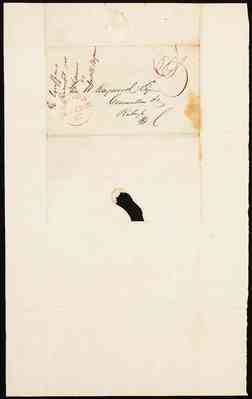folder 156: Correspondence, January–May 1839
January 4, a letter about Rachel, an enslaved woman who had self-emancipated to Raleigh, N.C. The letter is from Joseph I. Dillard, Hinds City, Miss., to William Hutchins (folder 156).
March 17, a letter in which Henry, an enslaved person, was offered as security against a claim, with the possibility of selling him, in a letter from John S. Haywood in Greensboro, Ala., to George W. Haywood in Raleigh. Charlotte, an enslaved woman who had a young child still breastfeeding; Sarah Ann, an enslaved woman who was pregnant; Maria, an enslaved woman; Abner, an enslaved man who was disabled by Scrofula, a type of tuberculosis infection, and hip joint disease; Weston, an enslaved man; Catharine, an enslaved woman; and an unnamed enslaved child referred to as "Mrs. Pasteur's boy" are also mentioned in the letter that describes strained finances and management of the Alabama plantation, including predictions of how much cotton could be harvested by enslaved people, the considerations of health and skill in hiring out enslaved people (folder 156)
May 3, letter in which Weston; Zepha; Mary, who was falsely rumored to have self-emancipated; Sylvia, who was resistant to the idea of being hired out; Catharine; Lucy; and Alex, all may have been members of a group of enslaved people who recently had been removed from Raleigh on 32 day trip to Greensboro, Ala. John S. Haywood in Greensboro, Ala., described the enslaved people, including his concerns for their acclimation to the Alabama weather in a letter to his sister Eliza E. Haywood in Raleigh (folder 156).
Other materials include: January 3, letters from Eliza E. Haywood to her brothers Fabius and George thanking them for enabling her to keep the family home; November 16, Joseph B. Hinton, Raleigh, to George W. Haywood; February 12, 1842, same to same. There are several letters from Rebecca Jane Haywood Hall to Eliza E. Haywood, and scattered letters 1839-41 from Reverdy Johnson to George W. Haywood.




